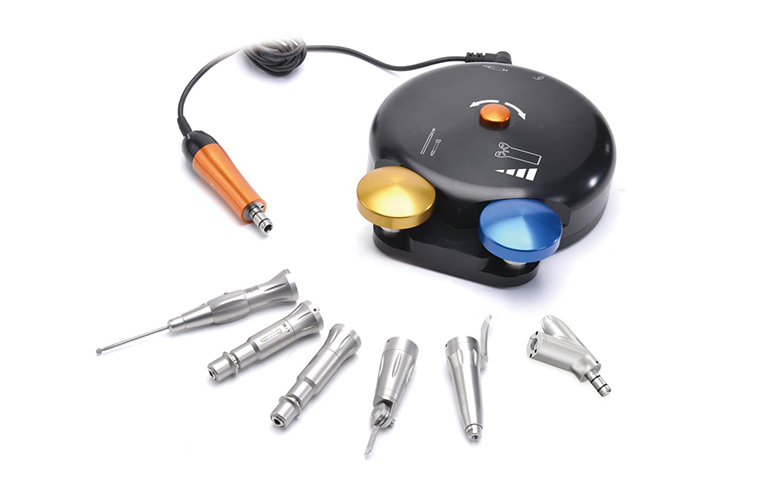Technical Origins and Development
The emergence of micro type orthopedic tool stems from advancements in minimally invasive surgery and materials science. By the late 20th century, the limitations of traditional pneumatic or electric tools in terms of size and precision became apparent as orthopedic surgery increasingly demanded accuracy and reduced trauma. Early power tools relied on bulky motors and mechanical transmission systems, which lacked flexibility and safety.
Key technological breakthroughs include:
- Micro Motor Technology: The maturation of brushless DC motors and piezoelectric ceramic actuators enabled millimeter-scale miniaturization while maintaining high torque (>5 N·cm) and rotational speeds (10,000–80,000 rpm).
- High-Temperature Sterilization Materials: Titanium alloys and nanoceramics allowed devices to withstand over 1,000 cycles of high-pressure sterilization at 134°C, reducing infection risks.
- Intelligent Feedback Mechanisms: Integrated torque sensors and thermal control modules dynamically adjust speed based on bone density, preventing accidental perforation or thermal damage.
Clinical Applications and Advantages
1. Minimally Invasive Spinal Surgery
- Percutaneous Pedicle Screw Placement: Hollow screws are inserted through millimeter-scale incisions, reducing intraoperative blood loss to <20 mL and lowering screw misplacement rates from 15% to <3%.
- Foraminoplasty: Micro grinders precisely expand narrow anatomical spaces, minimizing nerve root injury.
2. Joint Replacement and Repair
- Unicompartmental Knee Arthroplasty: Sub-millimeter osteotomy precision preserves >95% of healthy bone, shortening recovery by 30–50%.
- Rotator Cuff Repair: Arthroscopic debridement of calcified lesions improves postoperative functional scores by 30%.
3. Trauma and Bone Tumor Surgery
- Minimally Invasive Pelvic Fixation: Percutaneous screw placement reduces incision size to 1.5 cm and intraoperative radiation exposure by 70%.
- Bone Tumor Curettage: High-speed irrigation systems thoroughly remove tumor nests while protecting surrounding neurovascular bundles.
Micro type orthopedic tool vs. Traditional Handheld Tools

Future Directions
Intelligence and Precision
- Real-Time Bone Density Recognition: Impedance sensors adjust cutting parameters dynamically for conditions like osteoporosis.
- Hybrid Energy Output: Combining ultrasonic bone cutting with radiofrequency hemostasis for simultaneous cutting and coagulation.
Miniaturization and Biocompatibility
- Biodegradable Tool Heads: Magnesium alloys or polylactic acid materials enable post-procedural degradation, eliminating secondary surgeries.
- Nanoscale Applications: Magnetic-controlled microrobots (<1 mm) for intravascular bone repair or drug delivery.
Sustainability and Accessibility
- Reusable Designs: Sterilizable components withstand >500 cycles, reducing medical waste by 60%.
- Portable Systems: Compact, sterilizable kits for battlefield or remote-area fracture management.
Cross-Disciplinary Integration
- Remote Surgical Support: 5G-enabled expert guidance for underserved regions.
- Neuro-Interventional Applications: Flexible robotic arms for ultra-minimally invasive spinal or cranial procedures.
Challenges and Industry Trends
- Technical Limitations: Improving micro motor lifespan from 600 to >2,000 hours under continuous high load.
- Standardization Gaps: Lack of unified performance metrics (e.g., cutting efficiency, sterilization tolerance).
- Training Needs: Simulated platforms and certification programs to shorten the learning curve.
Conclusion
Micro type orthopedic tool redefine trauma boundaries through extreme miniaturization and intelligent feedback, transforming precision from “operator-dependent skill” to “tool-embedded capability.” By reducing complications and improving outcomes, these systems are poised to become standard in orthopedic practice. Future advancements in materials, energy efficiency, and cross-disciplinary technologies will drive progress toward scarless interventions and universal applicability, revolutionizing patient care worldwide.
